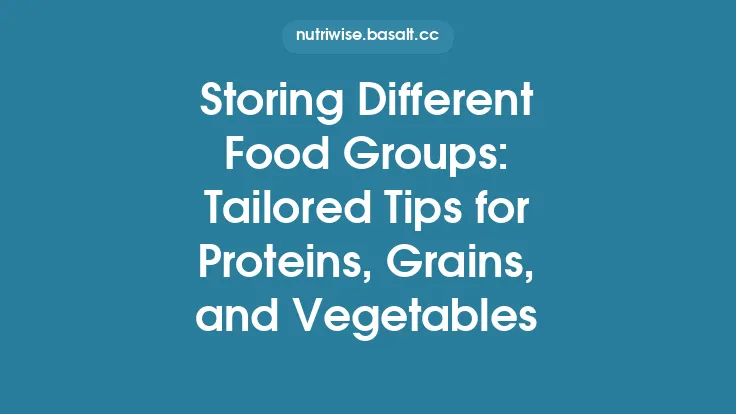Meal planning is more than a weekly chore; it is a strategic framework that aligns what you eat with what you actually have, what you can realistically prepare, and what you can afford to waste. When done thoughtfully, it creates a feedback loop between your pantry, refrigerator, and grocery list, ensuring that each purchase serves a purpose and that surplus ingredients are either used promptly or stored correctly. This approach not only saves money but also dramatically cuts the amount of food that ends up in the trash, making it a cornerstone of any sustainable‑eating practice.
Understanding the Role of Meal Planning in Waste Prevention
At its core, meal planning bridges the gap between intention and execution. By deciding in advance which dishes you will prepare, you can:
- Map Ingredients to Meals – Identify exactly which vegetables, proteins, grains, and pantry staples are required for each recipe.
- Spot Overlaps – Recognize common components across multiple meals (e.g., a batch of roasted carrots can serve a soup, a side dish, and a salad topping).
- Allocate Shelf‑Life Windows – Align perishable items with the meals that will use them before they deteriorate.
When these steps are integrated into a single workflow, the likelihood of buying “just in case” items drops dramatically, and the chance that an ingredient sits idle until it spoils is minimized.
Conducting a Kitchen Inventory Audit
Before you can plan meals that respect what you already own, you need a reliable snapshot of your current stock. A systematic inventory audit involves three layers:
| Location | Method | Frequency |
|---|---|---|
| Pantry | Pull out all dry goods, group by category (canned, grains, spices). Record quantity, package size, and “best‑by” date. | Monthly |
| Refrigerator | Remove items, note produce type, weight/volume, and purchase date. Use a simple color‑coded sticker system (green = <3 days, yellow = 3‑5 days, red = >5 days). | Weekly |
| Freezer | List frozen proteins, vegetables, and prepared meals. Include the date frozen and an estimated thaw‑by date. | Quarterly |
A spreadsheet or a dedicated inventory app can store this data. The key is to keep the list dynamic: every time you add or remove an item, update the record. Over time, the inventory becomes a living database that feeds directly into your meal‑planning template.
Building a Flexible Meal Calendar
A rigid, day‑by‑day menu can be beautiful on paper but brittle in practice. Instead, design a flexible meal calendar that separates “core meals” from “variable components.”
- Core Meals (Fixed) – These are the main dishes you are committed to preparing (e.g., Monday: Lentil stew; Thursday: Baked salmon).
- Variable Components (Swappable) – Side dishes, sauces, or grain bases that can be interchanged based on what’s on hand (e.g., quinoa, roasted potatoes, sautéed greens).
By anchoring the week with a handful of core meals and allowing the sides to rotate, you create room to incorporate unexpected ingredients that may appear in your inventory (e.g., a sudden surplus of zucchini from a farmer’s market).
A visual calendar (paper wall chart or digital board) with color‑coded blocks for core vs. variable meals makes it easy to see at a glance where flexibility exists.
Integrating Seasonal and Local Produce
Seasonality is a natural ally in waste reduction. Produce that is in season is typically more abundant, cheaper, and has a longer shelf life because it travels a shorter distance from farm to table. To harness this advantage:
- Create a Seasonal Produce List – Use a reliable source (e.g., USDA seasonal guide) to note which fruits and vegetables peak each month.
- Map Seasonal Items to Variable Components – If kale is abundant in winter, plan for it as a frequent side or salad base.
- Leverage Local Market Schedules – Many community farms have weekly harvest calendars. Align your variable components with these schedules to ensure you’re buying what’s freshest and most plentiful.
When seasonal produce is woven into the flexible portion of your calendar, you reduce the need to purchase out‑of‑season items that often come pre‑packaged and have a shorter usable window.
Quantifying Ingredients: From Recipe to Shopping List
A common source of overbuying is the “eyeball” approach to ingredient quantities. Converting recipes into precise measurements eliminates guesswork. Here’s a step‑by‑step method:
- Standardize Servings – Decide on a universal serving size for each family member (e.g., 150 g protein, 200 g vegetables).
- Scale Recipes – Use a simple spreadsheet formula: `=ROUND(Original_Quantity * Desired_Servings / Original_Servings, 1)`.
- Consolidate Overlaps – If two recipes call for 300 g of carrots and 200 g of carrots, sum them to a single 500 g purchase.
- Apply “Buffer” Rules – Add a modest buffer (5‑10 %) only for ingredients with a long shelf life (e.g., rice, beans). Avoid buffers for highly perishable items.
The output is a master shopping list that aggregates all needed quantities, eliminates duplicate purchases, and clearly indicates which items are already covered by existing inventory.
Leveraging Technology: Apps and Digital Tools
Modern meal‑planning can be streamlined with a suite of digital tools that automate many of the manual steps:
- Meal‑Planning Apps (e.g., Paprika, Mealime) let you import recipes, assign them to calendar days, and auto‑generate shopping lists based on scaled quantities.
- Inventory Management Apps (e.g., Sortly, NoWaste) sync with barcode scanners, allowing you to log items instantly and receive expiration alerts.
- Spreadsheet Templates – For those who prefer full control, a Google Sheet with built‑in formulas can track inventory, calculate needed purchases, and even visualize waste trends with charts.
When these tools are linked—inventory feeding directly into the meal‑planning app—the system becomes self‑correcting: the moment you log a new item, the next week’s shopping list updates automatically.
Implementing the FIFO System and Proper Labeling
Even the best‑planned meals can go awry if older items sit behind newer ones. The First‑In‑First‑Out (FIFO) principle ensures that the oldest stock is used first:
- Designate “Older” and “Newer” Zones – In the fridge and pantry, keep a clear visual divider. Place newly purchased items at the back, older items at the front.
- Label with Date Stamps – Use a waterproof marker or a label printer to write the purchase or freeze date on each package.
- Weekly “Spot Check” – During your inventory audit, move any items that have been sitting for more than a week to the front of the shelf.
Combined with the flexible meal calendar, FIFO guarantees that the ingredients you’ve earmarked for upcoming meals are indeed the ones that will be used first.
Adjusting Plans Based on Real‑Time Changes
Life is unpredictable—spontaneous guests, sudden sales, or a missed grocery trip can disrupt even the most meticulous plan. A resilient system incorporates real‑time adjustments:
- Swap Slots – If a planned dinner is canceled, replace it with a “quick‑use” meal that utilizes ingredients nearing the end of their shelf life.
- Add “Catch‑All” Days – Reserve one or two evenings per week as “flex days” where you intentionally cook with whatever is left in the fridge.
- Dynamic List Updates – Use a shared note (e.g., on a family phone) where anyone can add or remove items on the fly, ensuring the shopping list stays current.
These strategies keep waste low without forcing you to stick rigidly to a plan that no longer fits reality.
Tracking Waste and Refining Your System
To truly understand the impact of your meal‑planning efforts, you need a waste‑tracking loop:
- Log Discards – Each time you throw away food, note the item, quantity, and reason (e.g., “over‑ripe banana, no recipe”).
- Analyze Patterns – Monthly, review the log to spot recurring culprits (e.g., “leafy greens” consistently spoil).
- Iterate – Adjust your inventory audit frequency, portion estimates, or flexible component choices based on the data.
Over time, you’ll see a measurable decline in waste volume, and the data will guide you toward ever‑more efficient planning.
Scaling Meal Planning for Different Household Sizes
The principles above apply universally, but the execution varies with household composition:
- Singles or Couples – Emphasize batch‑prep of base ingredients (e.g., cooked grains, roasted vegetables) that can be portioned into multiple meals.
- Families with Children – Involve kids in the inventory audit and calendar selection; visual charts help them understand why certain foods appear more often.
- Multi‑Generational Homes – Create sub‑calendars for each generation’s dietary preferences, then overlay them to find common meals that satisfy everyone while minimizing duplicate purchases.
Customizing the level of detail and the visual tools to the household’s size and dynamics ensures the system remains user‑friendly and sustainable.
Closing Thoughts
Meal planning, when approached as a systematic, data‑driven practice, becomes a powerful lever for reducing food waste. By starting with a thorough inventory, building a flexible calendar, quantifying every ingredient, and continuously feeding real‑time data back into the system, you create a virtuous cycle where each grocery trip is purposeful, each ingredient is used, and each discarded item becomes a rare exception rather than the norm. The result is not only a lighter environmental footprint but also a healthier wallet and a more intentional relationship with the food that nourishes you.





